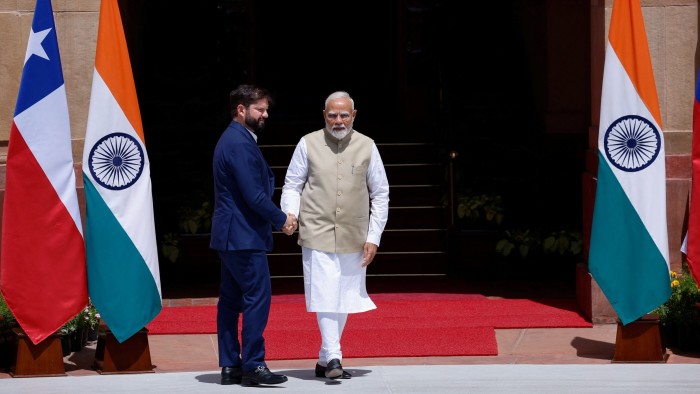Unlock the Editor’s Digest for free
Roula Khalaf, Editor of the FT, selects her favourite stories in this weekly newsletter.
India’s prime minister Narendra Modi this month hailed a “new energy” in New Delhi’s relationship with the “entire” Latin America, as the world’s fastest-growing major economy tries to deepen ties with the continent to secure the minerals it needs to meet its ambitious green energy targets.
Latin America has the world’s largest lithium reserves and India is pushing mining groups to pursue reserves in the “lithium triangle” — between Argentina, Bolivia and Chile — where most of the region’s proven resources are located.
In recent weeks, Modi met Chilean President Gabriel Boric in New Delhi to discuss the “long-term supply of minerals” — particularly those necessary for the energy transition, such as copper and lithium. “Naturally, critical minerals are a key piece in the matrix,” said Periasamy Kumaran, a top Indian foreign ministry official, referring to Chile.
The newfound quest for minerals reflects Modi’s ambitious commitment of reaching net zero carbon emissions by 2070 in a country that is the third-biggest carbon polluter globally.
“India’s outreach to Latin America reflects a growing awareness in Delhi that securing access to critical minerals is now a strategic imperative,” said Oliver Stuenkel, a BRICS expert at Brazil’s Fundação Getulio Vargas. “This is about boosting India’s role in the global supply chain of the energy transition.”
New Delhi last month also hosted an India-Latin America business gathering, focused on access to the minerals needed to meet its ambitious goal of having 30 per cent of its vehicles powered by electricity by 2030.
“They made it clear, almost obsessively, that they want to source critical minerals — it’s a raison d’être now,” said a South American diplomat in India.
India Business Briefing
The Indian professional’s must-read on business and policy in the world’s fastest-growing big economy. Sign up for the newsletter here
During Boric’s visit, Chile’s Codelco, the world’s biggest copper miner, agreed a deal with India’s state-run Hindustan Copper. It also said it would supply copper concentrates to the Adani Group, owned by one of India’s most powerful tycoons and a Modi ally.
“India has huge appetite for copper, there’s a sense of urgency — we are a perfect match,” Máximo Pacheco, Codelco’s chair told the Financial Times in New Delhi.
He added that “India will absolutely soon become a big buyer of Chilean lithium”, a key component for electric vehicle batteries. The state-owned miner is taking a majority stake in Chile’s SQM, the world’s second-largest producer, as part of Boric’s strategy of bringing lithium under state control.
New Delhi has opened several new embassies in Latin America since Modi took office a decade ago, the latest in lithium rich Bolivia. “Our idea is to open as many embassies as possible,” said a senior Indian diplomat. “We were not focused on Latin America forcefully — now we are.”
Last year, India signed an agreement with Argentina to lease five lithium blocks for exploration, and eventual extraction, in a “historic” deal between India’s state-owned Khanij Bidesh India and Catamarca Minera y Energetica Sociedad del Estado, which is owned by the provincial government.
“When it comes to India and Latin America, India cannot compete with China,” said Manjeet Kripalani, executive director at Gateway House Indian Council on Global Relations in Mumbai.
“But critical minerals are very important to us, we have great needs. If we want to sustain more than 1.4bn people, we need to go out to get the minerals we need and we will do that within our capacity.”
Foreign minister Subrahmanyam Jaishankar met his Bolivian counterpart Celinda Sosa in March as companies from India and Bolivia are “exploring the lithium ion battery sector in Bolivia”, according to the Indian government.
While lithium was only recently found in India’s disputed northern territory of Jammu and Kashmir and the central state Chhattisgarh, India has modest reserves of copper in Rajasthan, Jharkhand and Madhya Pradesh.
https://www.ft.com/content/0bf2494f-42fd-49d7-9f64-a54ea9b45fe7


